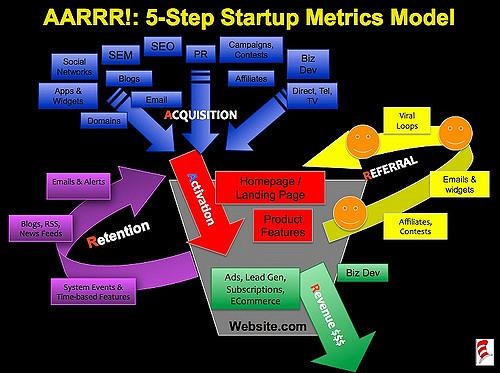SaaS Actionable Metrics: A Guide to Tracking AARRR
Whether you are starting a business or working on expanding your current operations, growing your customer base is essential to the success of the entrepreneur. Developing and optimizing your sales funnel is the only way to increase your pool of consumers by converting potential customers. One of the simplest and most effective models for this kind of growth is AARRR.
In this article, we’ll show you the best methods of AARRR tracking for SaaS actionable metrics.

Understanding AARRR
For those who haven’t stepped into the realm of this framework, AARRR stands for
- Acquisition
- Activation
- Retention
- Referral
- and Revenue
These actionable metrics help you to understand your consumers in order to better market your product. Its simple implementation allows you to quickly adjust and fine tune your funnel without a specialized understanding of the tech world.
The information gathered from AARRR tracking helps you to make statistical and factual decisions that can be a powerful ally in developing your startup. The “trick” with this method of tracking, if you can even call it that, is getting people to move from signing up for a product to handing over their money for your service or product. The process is profoundly simpler than most think, and this is how it works.
Step One: Acquisition
When it comes to SaaS, signing up for something usually starts with a free trial that allows the customer to experience a full or limited version of what your business has to offer. This could also mean getting potential customers to sign up for a newsletter or other form of micro-conversion.
The number one mistake that most startups make is in thinking that a larger number of conversions is the goal. In fact, there’s nothing wrong with mass acquisition. If you find a channel to gain the right followers it can help you out significantly in converting sales-qualified leads. Simply put, a handful of leads in your target demographic will lead to more sales down the road than a thousand bad leads that would do nothing to raise your number of conversions.
A good SQL will easily make the transition to the rest of the steps in AARRR, making proper targeting a crucial element in starting the framework of this funnel. Working on your Traffic Acquisition will ensure better leads, as will making the process more visually appealing. Try using a font preview tool, varying color palettes, or simple yet intriguing animations.
Step Two: Activation
It might sound strange to hear that people sign up for a free trial then never use it, but it happens more often than you might think. Activation simply means that they are using your product after signing up, which is where onboarding comes into play.
People logging in need to experience and understand the value of what you are offering. How can it help them with their job, ease their daily obligations, or enrich their lives? Consider these questions to help you tweak the user experience of your product.
When you do experience a prospect who does not log in, utilize your newsletter to remind them what value your product offers. It is also highly advised to send a personalized, targeted email to encourage their interaction.
Step Three: Retention
The main goal of any free trial is to create a user who wishes to continue using your product. Retention can be tough, as many users waste your time and money by only ever using the free trial. Ideally, you want these “free sample” users to come back for the main course, so to speak.
These repeat users offer vital data that can help you tweak your funnel and create an ideal sign-up -to-sales conversion rate. Keep in mind that no app becomes as popular as Snapchat or Facebook in a month’s time. Even two logins a month from prominent SQLs can be great news for a fresh startup.
In order to increase retention, try to remind users who have taken advantage of your free trial that your business hasn’t gone anywhere and still offers the same value or new features.
Step Four: Referral
Let’s take a closer look at those two highly targeted SQLs to better understand referral. These users understand the market you work in and, more importantly, have connections that are just as interested as they are in this market and its products. That means they’ll be talking about their experience with your business to those connections, aiding your organic growth.
Utilizing social media marketing practices, you can quickly draw leads from their pool of connections to add to your customer pool. Think of it like irrigating crops, only you will be setting up harvest for a steady flow of sales.

Step Five: Revenue
At this stage, at least of handful of people are actively using your product and paying for it. All that’s left for you to do here is count the numbers of customers that you have and collect your earnings.
There are a variety of different metrics available for analyzing the health of your company, but the AARRR tracking process itself ends with the number of recurring customers your business has acquired.




